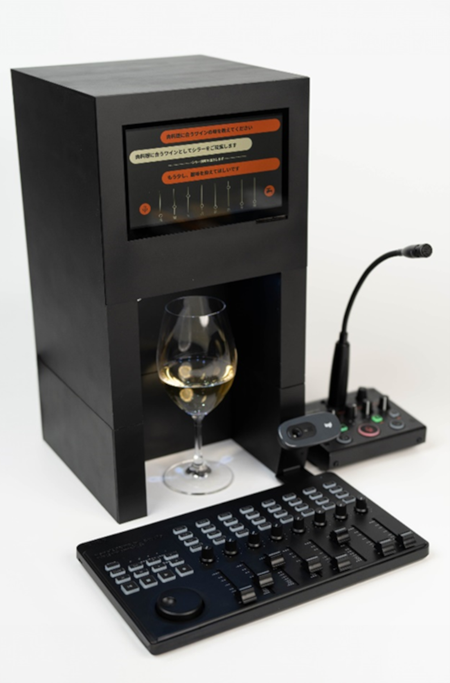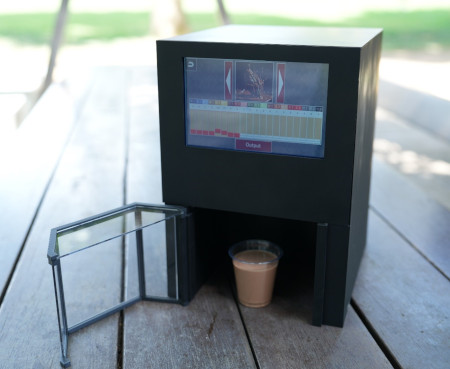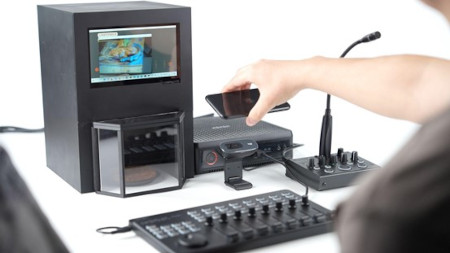[Press Release] The MIYASHITA Homei laboratory in the School of Interdisciplinary Mathematical Sciences at Meiji University announces the TTTV3, a seasoning device that uses AI to estimate tastes and reproduce differences in production areas
Sep. 13, 2023
The MIYASHITA Homei laboratory in the Department of Frontier Media Science, School of Interdisciplinary Mathematical Sciences, Meiji University developed the TTTV3 (Transform The Taste and reproduce Varieties), a seasoning device that reproduces differences of tastes in production areas and varieties.

Upgraded from the taste media Taste the TV (TTTV) developed by Professor Miyashita for the INNO-vation Program of the Ministry of Internal Affairs and Communications, this device reproduces tastes by spraying a mixture of liquids that have different tastes, such as the basic five tastes (sweet, sour, salty, bitter, and umami) and spicy tastes.
The TTTV3 can control tastes in 0.02 ml increments, more finely than professional cooks. It features high taste reproducibility by using multiple liquid solutions for one taste. Moreover, it can also “subtract tastes”, or make a certain taste lighter than that of the original food, by adding an alkaline substance to neutralize the taste, utilizing taste modulators, or using the masking effect of another taste. As there are 20 taste canisters and the amount of solution from each canister can be controlled in 1,000 steps, the number of taste combinations that can be reproduced is 10 to the power of 60 (10^60). This has enabled fine reproduction of tastes, even including taste differences between wines, cacao, or pickled ume in production areas and varieties.

Figure 2: Insides of the TTTV3

Figure 3: Battery-powered and available for outdoor use
In addition, the device can now be operated in coordination with LLM such as ChatGPT. When you utter the name of a dish into the microphone, or show an image of a dish to the webcam, LLM can estimate the taste to be output. For example, when you just show a picture of a memorable dish you had during a holiday, the device estimates and reproduces its taste.

Figure 4: Using the LLM chat system of the TTTV3. Based on the picture of a hamburger eaten during a holiday, AI estimates and outputs the taste of a hamburger sauce
There are three related presentations: the demonstration presentation on the control of wine tastes, such as making white wine taste like red wine; the demonstration presentation on the reproduction of taste differences of cacao in production areas; and the on-stage presentation on vision for the future to be brought by the TTTV3.
・Minji Kim, Shuto Murakami, Homei Miyashita. Reproduction of wine tastes using the TTTV3, Entertainment Computing Symposium Proceedings, Vol. 2023, 2023.
・Yuki Hou, Miku Fukaike, Nobuhito Kasahara, Shuto Murakami, Takegi Yoshimoto, Yoshiki Minato, Ryuto Tomihari, Takeharu Kawata, Homei Miyashita. Method to quantify taste differences of cacao in production areas and reproduce them with a pure substance, Entertainment Computing Symposium Proceedings, Vol. 2023, 2023.
・Homei Miyashita, Shuto Murakami, Chihiro Otomo, Miku Fukaike. TTTV3 (Transform The Taste and reproduce Varieties): Seasoning mechanism that reproduces differences of tastes in production areas and varieties, and taste expression by LLM, Entertainment Computing Symposium Proceedings, Vol. 2023, 2023.
TTTV3 (Transform The Taste and reproduce Varieties): Seasoning mechanism that reproduces differences of tastes in production areas and varieties, and taste expression by LLM
Reproduction of wine tastes using the TTTV3
Method to quantify the taste differences of cacao in production areas and reproduce them with a pure substance

Figure 1: TTTV3 system, equipped with a touch panel, webcam, microphone and operation controller
Upgraded from the taste media Taste the TV (TTTV) developed by Professor Miyashita for the INNO-vation Program of the Ministry of Internal Affairs and Communications, this device reproduces tastes by spraying a mixture of liquids that have different tastes, such as the basic five tastes (sweet, sour, salty, bitter, and umami) and spicy tastes.
The TTTV3 can control tastes in 0.02 ml increments, more finely than professional cooks. It features high taste reproducibility by using multiple liquid solutions for one taste. Moreover, it can also “subtract tastes”, or make a certain taste lighter than that of the original food, by adding an alkaline substance to neutralize the taste, utilizing taste modulators, or using the masking effect of another taste. As there are 20 taste canisters and the amount of solution from each canister can be controlled in 1,000 steps, the number of taste combinations that can be reproduced is 10 to the power of 60 (10^60). This has enabled fine reproduction of tastes, even including taste differences between wines, cacao, or pickled ume in production areas and varieties.

Figure 2: Insides of the TTTV3

Figure 3: Battery-powered and available for outdoor use

Figure 4: Using the LLM chat system of the TTTV3. Based on the picture of a hamburger eaten during a holiday, AI estimates and outputs the taste of a hamburger sauce
・Minji Kim, Shuto Murakami, Homei Miyashita. Reproduction of wine tastes using the TTTV3, Entertainment Computing Symposium Proceedings, Vol. 2023, 2023.
・Yuki Hou, Miku Fukaike, Nobuhito Kasahara, Shuto Murakami, Takegi Yoshimoto, Yoshiki Minato, Ryuto Tomihari, Takeharu Kawata, Homei Miyashita. Method to quantify taste differences of cacao in production areas and reproduce them with a pure substance, Entertainment Computing Symposium Proceedings, Vol. 2023, 2023.
・Homei Miyashita, Shuto Murakami, Chihiro Otomo, Miku Fukaike. TTTV3 (Transform The Taste and reproduce Varieties): Seasoning mechanism that reproduces differences of tastes in production areas and varieties, and taste expression by LLM, Entertainment Computing Symposium Proceedings, Vol. 2023, 2023.
TTTV3 (Transform The Taste and reproduce Varieties): Seasoning mechanism that reproduces differences of tastes in production areas and varieties, and taste expression by LLM
Reproduction of wine tastes using the TTTV3
Method to quantify the taste differences of cacao in production areas and reproduce them with a pure substance
Related links


